SUBJECTS
GRADE
Show Results
Question–and–Answer Music Compositions

Lesson Summary
- Identify interrogative (question) and declarative (answer) sentences.
- Represent musical phrases with pictures (iconic notation).
- Create musical compositions.
Lesson Plan and Procedure
Lesson Key Facts
- Grade(s): 1
- Subject(s): English Language Arts, Math, Music
- Duration of lesson: Three sessions, 30-45 minutes each
- Author(s): Emily Soderborg
Activity 1: Playing Song Games and Creating Iconic Notation
Students will learn various song games that have questions and answers in the lyrics. To be successful with later activities, the students need to be familiar with three to four songs. These songs can be taught in 10-minute increments, one song a day, for several days. Because the songs are learned quickly, they can be used as brain breaks, transition activities, or fillers when you have a few minutes available.
Four songs with complete game instructions are listed with PDFs in the equipment and materials needed section: “Cuckoo,” “Hickety Tickety,” “Old Mother Witch, and “We Are Dancing in the Forest.” However, you can use any songs or nursery rhymes that have lyrics that ask and answer questions. Other song suggestions include “Doggie, Doggie Where’s Your Bone,” “Engine, Engine Number 9,” “Baa Baa Black Sheep,” “Simple Simon Met a Pie Man,” “How Much Is that Doggie in the Window,” and “Paw, Paw Patch.”
As students become familiar with a song, have the class create icons to represent each phrase in the song. Sing the first phrase of the song and then pause.
Teacher: How could we represent this phrase with its own unique picture?
Listening to the student’s suggestions, draw a simple picture on the board. Continue singing. Pause after each phrase to draw an icon for the phrase. Do this for three to four songs. These pictures become iconic notation for phrases within each song.
![]()
After creating icons, sing through the entire song by pointing to the phrases.
Teacher: Let’s double-check to see if we really know which phrase each icon represents. I’ll move my finger around, pointing randomly to the pictures we’ve created, and every time I point to a picture, we’ll sing the phrase that matches the icon I’m pointing to.
Teacher tip: Helping students create icons may seem time consuming; however, the process gives students ownership and is especially beneficial when students create their own compositions in later activities.
Assessment:
- Students can sing with others and by themselves.
- Students can sing a variety of simple songs.
- Students can use pictures to represent phrases, thus creating iconic notation for known songs.
- Students can sing individual phrases of songs while reading iconic notation.
Activity 2: Finding Questions and Answers
Note: Make a large copy of each of the icons the students helped to create in activity 1 before you begin activity 2.
Start by playing one or two of the question-and-answer games from activity 1 as a warmup activity.
Show students a sign of a large question mark.
Teacher: Does anyone know what this symbol means?
Discuss that it is a question mark. Have a student ask you a question. Instead of answering the question, respond with another question.
Teacher: What did you notice about my response?
Briefly discuss the difference between questions, answers, statements, exclamations, and commands. Show students the sign language letters q and a.
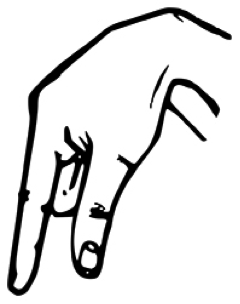
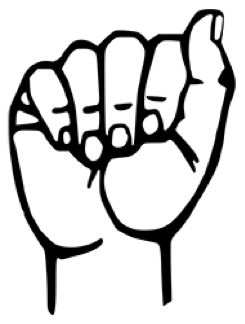
Teacher: Today we are going to listen for questions and answers in songs we know. When you hear a question in the song, show a sign language q, and when you hear an answer in the song, show a sign language a.
Sing through multiple songs from the games in activity 1. As you sing each phrase, place a large cutout copy of each icon the students helped create on the board. Invite the students to share some of the questions and answers they heard in the songs.
Teacher: Not every phrase in the song is a question or an answer. The lyrics might be an exclamation, a statement that isn’t connected to a question, or a command instead. But today we are trying hard to find just the questions and answers in our songs. Let’s listen again and see if we can find all the questions and all the answers.
Sing through a song one phrase at a time by pointing to the icon representing that phrase. Pause after singing the first phrase.
Teacher: Was that phrase a question, an answer, or neither one? Show me with your hands what you heard, rather than using your voice.
Sing through the first phrase again and give wait time to allow students to show you what they hear by signaling with their sign language. If the first phrase in the song is a question, write a q underneath the icon to solidify what the students are showing with their hands. If it is an answer, write an a underneath the icon. If the phrase is a statement, a command, or an exclamation, write an x underneath the icon so the students remember that it is neither a question nor an answer.
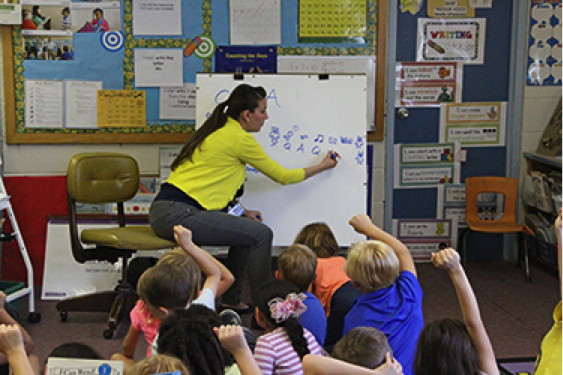
Continue singing through the song, pausing after each phrase. Have the students use their sign language to show whether it is a question, an answer, or neither one.
After singing all the songs and labeling each phrase in the songs, help the students organize all the pictures into categories. Move the question icons into one column and the answer icons into another. Remove the phrases that are neither a question nor an answer from the board. As a class, sing through all the question phrases, then sing through all the answer phrases.
Finish this activity by playing one or two of the song games from which you found questions and answers in the lyrics.
Assessment:
- Students can identify questions and answers in known song lyrics using sign language hand signs.
- Students can separate phrases in a song into categories.
Activity 3: Creating Question-and-Answer Music Compositions
Note: Make individual copies of the icons created in activity 1 before you start activity 3. Make sure to copy only the question-and-answer icons and to remove the icons that represent other types of phrases. It will help students if you put all of the question icons on one side of the paper and all of the answer icons on the other side of the paper when you make copies. Students may need several copies if they decide to use the same question or answer more than once.
Again, start by playing one or two of the question-and-answer games from activity 1 as a warm-up activity.
Teacher: Last time, we found all the questions and answers in our songs. As we sing through each song, show me again with sign language when you hear the questions and answers. Also, as we sing, we’ll need to double-check that all of our questions are on one side of the board and all of our answers are on the other side of the board.
This organization of icons will help you model for students how to compose a song using the question-and-answer icons.
Teacher: I am going to create a new song. I am going to pick one question from the songs we know and place that question’s icon here in the middle of the board, where everyone can see it. Next, I’m going to select an answer from all of these answers on the other side of the board. It can be from any song. The answer might sound silly in response to the question, but today we get to be silly when we write these songs! As I write the new song, I am going to follow this pattern: question/answer, question/answer, question/answer. To help all of us remember the pattern, I’m going to write QAQAQA on the board.
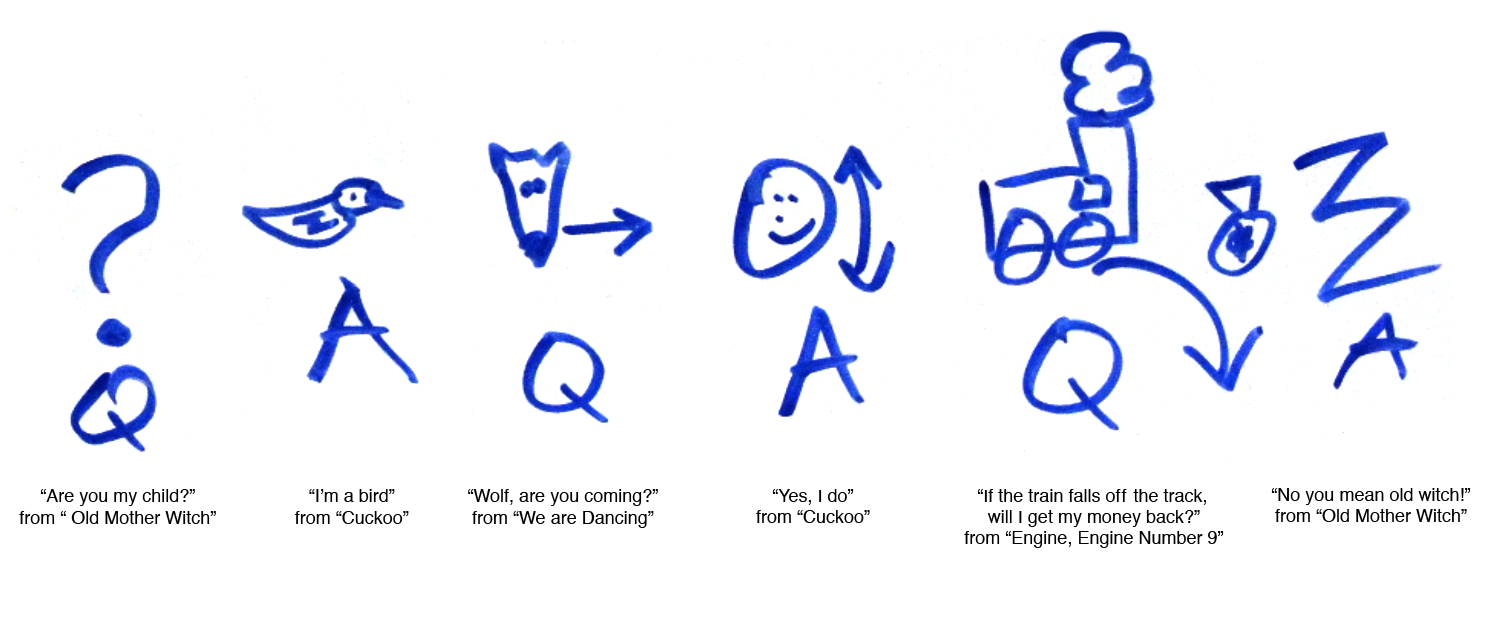
Finish your composition by adding two more questions and answers. See if the students can sing the new composition as you point to the pictures in order. The students should sing the melodies that match the phrases represented by the icons. The question would be sung to the melody of one song, and the answer might be sung to the melody of a different song. Switch around the questions and answers, but keep the form QAQAQA, and have individual students sing the new composition. This would be an appropriate time to remind students of patterns they have been studying in math. This question-and-answer pattern is similar to the AB math pattern students learn.
Select three students to choose any question from a song and three more to choose any answer from a song to create a class composition. Sing through the class composition together, and then have a few individual students sing the composition.
Teacher: Part of the reason we write down a composition is so that others can read it and perform it the way we intend it to be performed. Many composers use music notation, like this. (Hold up a piece of sheet music and point to the notes.) Today, we are using pictures or icons we drew to notate our songs, but we could write down our compositions any way we wanted, as long as other people are able to follow what we notate. Today each of us will write our own question-and-answer composition.
Teacher: It might be hard for someone outside our classroom to read your composition. To make our notations clearer, we are going to write the lyrics underneath each icon we 6 have chosen be a part of our composition. As a reminder, what should each question sentence start with? What should it end with?
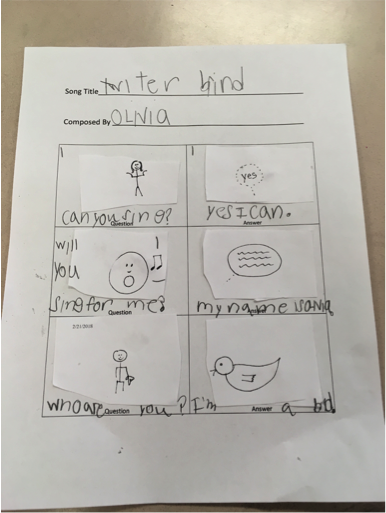
Write the rubric on the board for the students to follow:
- I picked three question pictures and three answer pictures to use in my composition.
- I glued the pictures to my composition outline, following the pattern QAQAQA.
- I wrote a title for my composition and wrote my name as the composer of the song.
- I wrote the lyrics underneath each icon. I started each sentence with a capital letter and finished with a question mark or period.
- I sang through my composition and had someone else sing through it.
Have each student create their own question-and-answer composition by cutting out the icons and gluing them to their composition outline. Remind the students to check the rubric to see if they have met all the criteria.
Invite the students to perform their composition for the whole class or in small groups, depending on how much time you have.
Teacher tip: This lesson may be used as a precursor to helping students frame questions that lead to scientific investigations. See grade 1 science standard 1: objective 2a.
Assessment:
- Students can write a question-and-answer composition that follows the QAQAQA pattern.
- Students can write question sentences that start with a capital letter and end with a question mark.
- Students can write answer statements that start with a capital letter and end with a period.
- Students can perform their composition for others.
Learning Objectives
- Identify interrogative (question) and declarative (answer) sentences.
- Add drawings to clarify ideas.
- Sing a variety of simple songs alone and with others.
- Organize personal musical ideas using iconic notation.
- Recognize and use patterns
Utah State Board of Education Standards
This lesson can be used to meet standards in many grades and subject areas. We will highlight one grade’s standards to give an example of application.
Grade 1 English Language Arts
Standard 1.R.5: Ask and answer questions about key details in a text. (RL & RI)
Standard 1.SL.2: Speak clearly and audibly while expressing thoughts, emotions, and ideas while asking and answering questions.
Grade 1 Music
Standard 1.M.CR.2: Demonstrate and discuss personal reasons for choosing favorite musical ideas.
Standard 1.M.CR.3: Organize personal musical ideas using iconic notation or recordings.
Standard 1.M.CR.4: Apply personal, peer, and teacher feedback to refine personal musical ideas.
Standard 1.M.P.3: Develop techniques and concepts to refine work for presentation by:
Singing a variety of simple songs.
Standard 1.M.CO.1: Describe how music relates to personal experience, use life experience and additional content knowledge to inspire and respond to music, and deepen understanding of another content area through music.
Grade 1 Math
Standard 1.MP.7: Look for and make use of structure. Recognize and apply the structures of mathematics such as patterns, place value, the properties of operations, or the flexibility of numbers. See complicated things as single objects or as being composed of several objects.
Equipment and Materials Needed
- Open space for song games
- Large poster of a question mark
- Board and markers (smart board or white board)
- Composition outline
- Pencils
- Enlarged copies of the icons students create in activity 1 (to sort in activity 2)
- Two copies of the question-and-answer icons per student (sorted into questions and answers; do not include any of the icons that are not questions or answers)
- Scissors and glue sticks
- A piece of sheet music to show music notation
- Music
- “Cuckoo” sheet music and game instructions
- “Hickety Tickety” sheet music and game instructions
- “Old Mother Witch” sheet music and game instructions
- “We Are Dancing” sheet music and game instructions
Additional Resources
Lesson extensions might include the following ideas:
- Teach about musical questions and answers (call-and-response sohttps://learningsuite.byu.edu/.ZLUW/student/topngs).
- Teach in connection to creating patterns, rather than just following patterns. Allow students to switch the patterns around when creating new compositions.
- Find imperative and exclamatory sentences in other song lyrics.
- Using the song questions as prompts to produce and expand complete simple and compound declarative, interrogative, imperative, and exclamatory sentences (first-grade language standard 1k).
Holy Names University—The American Song Collection
https://www.kodalycollection.org/collection.cfm
http://www.bethsnotesplus.com/find-songs
Image References
Image 1: Heidi Foss.
Image 2: Emily Soderborg.
Image 3: https://commons.wikimedia.org/wiki/File:Sign_language_Q.svg.
Image 4: https://commons.wikimedia.org/wiki/File:Sign_language_A.svg.
Image 5: Heidi Foss.
Image 6: Emily Soderborg.
Image 7: Emily Soderborg.

www.education.byu.edu/arts/lessons
 Download
Download